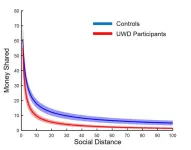(Press-News.org) When it comes to managing weight loss and type 2 diabetes with medications, research shows that it’s out with the old and in with the new. Investigators from Mass General Brigham looked at claims data from nearly 2 million people between 2021 and 2023 and their findings highlight a shifting landscape for weight loss and glucose managing medications. Those changes include a sharp climb in the use of newly approved medications, especially tirzepatide, which is sold under the brand name Mounjaro for diabetes treatment and Zepbound for weight loss. The use of medications previously common in the treatment of type 2 diabetes, including metformin, sulfonylureas, and insulin, decreased. Results are published in Annals of Internal Medicine.
“Taken together, these findings highlight the rapidly shifting landscape of prescribing patterns for glucose-lowering and weight-lowering medications,” said lead author John W. Ostrominski, MD, of the Cardiovascular Division, Division of Endocrinology, Diabetes and Hypertension, and Division of Pharmacoepidemiology and Pharmacoeconomics at Brigham and Women’s Hospital, a founding member of the Mass General Brigham healthcare system. “These changing trends likely reflect the combination of new evidence, increased awareness and prioritization of obesity treatment, and changing guidance for how to help patients manage these conditions.”
The study, which was funded by the National Institute of Diabetes and Digestive and Kidney Diseases, examined claims data among people with commercial insurance. The researchers report that in January 2021, approximately half of the weight-lowering medications initiated by people without diabetes were GLP-1RA-based medications such as semaglutide and tirzepatide. By December 2023, this percentage increased to nearly 90%, with tirzepatide being the most commonly started (31%). Use of other weight loss medications, such as phentermine and liraglutide, declined.
Among people with type 2 diabetes, 13% started GLP-1RA-based medications in January 2021. That rate rose to 35% by December 2023. Metformin, the most commonly started glucose-lowering medication in January 2021 (30%), declined to 19% by December 2023.
When the authors compared the immediate post-approval uptake of tirzepatide to other medications recently approved for type 2 diabetes or obesity, they found that the rise in tirzepatide’s use was steeper and more sustained.
“We saw a sharp uptake of tirzepatide after regulatory approval—these kinds of trends are important for patients, clinicians, researchers, and policymakers to be aware of,” said Ostrominski. “The rapidly expanding uptake of tirzepatide and GLP-1RA underscores the need for clinicians to become more familiar with their use, for researchers to improve understanding of their long-term effects, and for health policy that promotes sustained access and affordability.”
The researchers note several limitations to the work, including that it is uncertain whether the findings from commercially insured U.S. adults are generalizable to other populations and countries.
“Importantly, we don’t yet have long-term data from outcomes trials for tirzepatide as we do for GLP-1RA, but preliminary data are reassuring,” said Ostrominski. “In the future, data comparing the benefits of tirzepatide versus semaglutide for glycemic control, obesity management, and cardiovascular outcomes will help us have more informed conversations with patients about choosing the medication that’s right for them.”
Authorship: In addition to Ostrominski, Mass General Brigham authors include Janinne Ortega-Montie,l Helen Tesfaye, Caroline Alix, Elyse DiCesare, Elisabetta Patorno, Sara J. Cromer, Deborah J. Wexler, and Julie M. Paik.
Disclosures: Disclosure forms are available with the article online.
Funding: National Institute of Diabetes and Digestive and Kidney Diseases.
Paper cited: Ostrominski JW et al. “Trends in Utilization of Glucose- and Weight-Lowering Medications After Tirzepatide Approval in the United States” Annals of Internal Medicine DOI: 10.7326/ANNALS-24-02870
###
About Mass General Brigham
Mass General Brigham is an integrated academic health care system, uniting great minds to solve the hardest problems in medicine for our communities and the world. Mass General Brigham connects a full continuum of care across a system of academic medical centers, community and specialty hospitals, a health insurance plan, physician networks, community health centers, home care, and long-term care services. Mass General Brigham is a nonprofit organization committed to patient care, research, teaching, and service to the community. In addition, Mass General Brigham is one of the nation’s leading biomedical research organizations with several Harvard Medical School teaching hospitals. For more information, please visit massgeneralbrigham.org.
END
GRAND RAPIDS, Mich. (April 14, 2025) — Van Andel Institute has named renowned physician-scientist J. Timothy Greenamyre, M.D., Ph.D., as recipient of its 2025 Jay Van Andel Award for Outstanding Achievement in Parkinson’s Disease Research.
The award will be presented during Grand Challenges in Parkinson’s Disease, VAI’s flagship annual Parkinson’s disease symposium, Sept. 9–10, 2025.
Greenamyre’s pioneering research into the interactions between genes and the environment has vastly improved our understanding of Parkinson’s development and progression. He has published more than 200 articles detailing ...
Embargoed for release until 5:00 p.m. ET on Monday 14 April 2025
Follow @Annalsofim on X, Facebook, Instagram, Threads, and LinkedIn
Below please find summaries of new articles that will be published in the next issue of Annals of Internal Medicine. The summaries are not intended to substitute for the full articles as a source of information. This information is under strict embargo and by taking it into possession, media representatives are committing to the terms of the embargo not only on their own behalf, but also on behalf of the organization they represent.
----------------------------
1. ...
Is sauerkraut more than just a tangy topping? A new University of California, Davis, study published in Applied and Environmental Microbiology suggests that the fermented cabbage could help protect your gut, which is an essential part of overall health, supporting digestion and protecting against illness.
Authors Maria Marco, professor with the Department of Food Science and Technology, and Lei Wei, a postdoctoral researcher in Marco’s lab, looked at what happens during fermentation — specifically, how the metabolites ...
Philadelphia, April 14, 2024 – Researchers from the Epilepsy Neurogenetics Initiative (ENGIN) at Children’s Hospital of Philadelphia (CHOP) have completed a comprehensive natural history study of SCN8A-related disorders, which represent a spectrum of neurological symptoms. The study, using retrospective clinical information analyzed through novel data analysis methods, revealed a range of seizure types and neurodevelopmental features, and identifies potential targets for future clinical trials. The findings were published online on April 14, 2025, in Neurology®, the medical journal ...
We’re living in a period where the gap between rich and poor is dramatic, and it’s continuing to widen. But inequality is nothing new. In a new study published in the journal PNAS, researchers compared house size distributions from more than 1,000 sites around the world, covering the last 10,000 years. They found that while inequality is widespread throughout human history, it’s not inevitable, nor is it expressed to the same degree at every place and time.
“This paper is part of ...
LA JOLLA (April 18, 2025)—Industrial farming practices often deplete the soil of important nutrients and minerals, leaving farmers to rely on artificial fertilizers to support plant growth. In fact, fertilizer use has more than quadrupled since the 1960s, but this comes with serious consequences. Fertilizer production consumes massive amounts of energy, and its use pollutes the water, air, and land.
Plant biologists at the Salk Institute are proposing a new solution to help kick this unsustainable fertilizer habit.
In a new study, the researchers identified ...
EMBARGOED UNTIL 15.00 US ET (20.00 BST) ON MONDAY 14 APRIL 2025
The study lead by Professor Dan Lawrence, of Durham University in the UK, found that across ten millennia, more unequal distributions of wealth correlated with longer-term human settlement.
However, the team are keen to stress that one factor is not causally dependent on the other, giving hope that humankind’s survival is not linked to ever increasing inequality.
The research is part of a Special Feature of the Proceedings of the National Academy of Sciences (PNAS), entitled Global Dynamics of Wealth Inequality.
Sustainability is defined by the ...
University of California, Davis researchers have developed a new, neuroplasticity-promoting drug closely related to LSD that harnesses the psychedelic’s therapeutic power with reduced hallucinogenic potential.
The research, published in Proceedings of the National Academy of Sciences, highlights the new drug’s potential as a treatment option for conditions like schizophrenia, where psychedelics are not prescribed for safety reasons. The compound also may be useful for treating other neuropsychiatric ...
Are there areas of the brain, which regulate prosocial, altruistic behaviour? Together with colleagues from the universities in Lausanne, Utrecht and Cape Town, researchers from Heinrich Heine University Düsseldorf (HHU) have studied a very special group of patients and established that the “basolateral amygdala” (part of the limbic system) plays an important role in this. In the scientific journal Proceedings of the National Academy of Sciences (PNAS), they describe that this region calibrates social behaviour.
Prosocial ...
PULLMAN, Wash. — Wealth inequality began shaping human societies more than 10,000 years ago, long before the rise of ancient empires or the invention of writing.
That’s according to a new study led by Washington State University archaeologist Tim Kohler that challenges traditional views that disparities in wealth emerged suddenly with large civilizations like Egypt or Mesopotamia. The research is part of a special issue of the Proceedings of the National Academy of Sciences, co-edited by Kohler and Amy Bogaard, an archaeologist at Oxford University in England.
Drawing on data from over 47,000 residential ...




